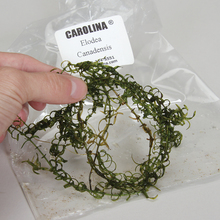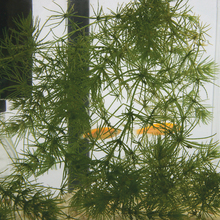62 — Elodea -- Photosynthesis and Cellular Respiration Lab
2016-03-06. By Kelly.

Fig. 1. Elodea canadensis.
Last week, we covered photosynthesis and cellular respiration which follows our chemistry unit. We used an elodea lab to show the connection between cellular respiration and photosynthesis. Bromothymol blue was used for the indicator solution of carbon dioxide. The students began the lab with a simple bromothymol blue activity in which they used a straw to blow into a cup half filled with a light blue solution (water with a few drops of bromothymol blue). The initial light blue color turns yellow as the carbon dioxide level increased when the students blew carbon dioxide into the solution. The students then reviewed the chemical formula of photosynthesis and cellular respiration that they studied earlier in the week. They used the chemical formulas to predict what would happen to the color of the bromothymol solution with a sprig of elodea (water plant). It's a great lab and the students can concretely connect their qualitative observation to the chemical formulas of photosynthesis and cellular respiration. For example the products of photosynthesis are glucose and oxygen and the reactants needed for this reaction are carbon dioxide, water, and light. Therefore if the bromothymol blue solution starts yellow in the sun it will turn blue with elodea. This lab also strongly reinforces the law of conservation of mass. And the icing on the cake is that all the supplies are provided by a wonderful group of students at UNC that formed SUCCEED, an organization that provides science materials to teachers. I can order my supplies from them at the beginning of the school year and they are delivered when I would like to do the activity with my students.
Calvin at SUCCEED emailed me and we had our dates set for when the supplies would arrive. But instead of Calvin coming with huge amounts of elodea, he arrived with only enough to run a class demo. Calvin told me that the elodea was doing well on Friday and on Monday when he went to collect the samples they were dead. There was only a small amount that was still alive. Fortunately, we still had science supply money in our account and we were able to purchase more elodea. I called to place the order and I was told that the Elodea Canadensis was currently unavailable. Apparently, the problem that Calvin had experienced was a problem that other biological supply companies were having. The Elodea Canadensis was dying in the southern states due to flooding condition. The Elodea Canadensis that the company was able to purchase was not as robust and it tended to die quickly. As a result, the company sent me an alternative called Elodea Chara. This is a plant that has much smaller leaves and smaller stems than the Elodea Canadensis. I just assumed that the elodea experiment that I had done in the past was going to be a flop. I was wrong. Although I couldn’t see big bubbles form on the leaf of the Elodea Chara, the plants did produce a distinct color change. In fact more of the student samples showed appropriate color changes that supported the processes compared to when we had used the Elodea Canadensis. When we plan the photosynthesis and cellular respiration lab next time, we may just make Elodea Chara our first choice.
Carolina Biological Supplies and Lab instructions and plant information:
http://www.carolina.com/teacher-resources/Interactive/using-aquatic-plants-to-demonstrate-photosynthesis/tr28607.tr
SUCCEED UNC:
http://campus-y.unc.edu/news/succeed-innovations-stem-education
Virtual Elodea Lab:
http://www.reading.ac.uk/virtualexperiments/ves/preloader-photosynthesis-full.html
The images in both figures are from the following link for the photosynthesis lab from Carolina Biological, a local company based in Burlington NC. (http://www.carolina.com/teacher-resources/Interactive/using-aquatic-plants-to-demonstrate-photosynthesis/tr28607.tr)

Fig. 2. Elodea chara.